Conditions
Ankle and Foot

Injuries to the ankle and foot are common, particularly among individuals engaged in physical activities. The most frequent type of injury is a sprain, often referred to as a “rolled ankle,” which involves overstretching or tearing of the ligaments that support the ankle.
Common Ankle and Foot Injuries
Ankle Sprains and Fractures
Ankle Sprains: This occurs when the ligaments that connect the bones in the ankle are overstretched or torn. Symptoms include pain, swelling, bruising, and difficulty walking. Ankle Fractures: A break in one or more of the bones that make up the ankle joint. Symptoms are similar to a sprain but often more severe, and may include deformity and inability to bear weight.
Achilles Injuries
Achilles Tendinitis: Inflammation of the Achilles tendon, which connects the calf muscles to the heel bone. It can cause pain and stiffness along the back of the leg near the heel. Achilles Rupture: A partial or complete tear of the Achilles tendon, often resulting in sudden, severe pain, swelling, and difficulty walking or standing on tiptoe.
Plantar Fasciitis
A condition characterized by pain in the heel or bottom of the foot. It is caused by inflammation of the plantar fascia, a thick band of tissue that runs across the bottom of the foot and connects the heel bone to the toes. Pain is usually worse in the morning or after long periods of standing.
Stress Fractures
Small cracks in the bones of the foot or ankle, commonly caused by overuse or repetitive force, often seen in athletes or individuals who engage in high-impact activities.
Symptoms include pain that worsens with activity and subsides with rest, as well as tenderness and swelling.
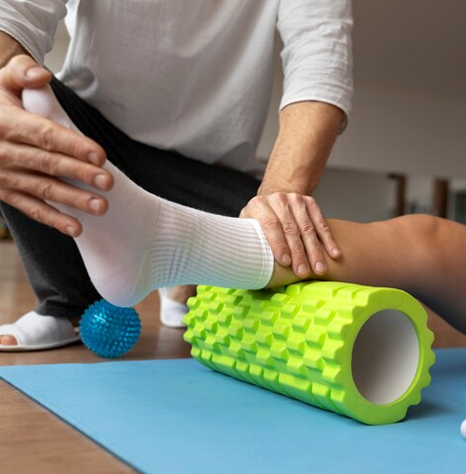
Back & Spine
Back pain is an extremely common condition, affecting approximately 80% of people at some point in their lives. The spine is a complex structure consisting of various components including joints, bones, muscles, ligaments, and nerves. Intervertebral discs between the vertebrae act as shock absorbers and facilitate movement in the spine. Pain can originate from any of these structures, leading to various types of back pain.
Common Causes and Conditions

Disc Injury
Intervertebral discs can become injured through herniation or degeneration, causing pain due to nerve compression or inflammation.
Sciatica
This condition involves pain that radiates along the path of the sciatic nerve, typically extending from the lower back down through the legs. It is often caused by compression of a lumbar nerve root.
Facet Joint Strain
The facet joints connect the vertebrae and help stabilize the spine. Strain or degeneration of these joints can cause localized pain and stiffness.
Post-Surgery Rehabilitation
After spinal surgery, patients often experience pain and require rehabilitation to restore function and reduce discomfort.
Postural Stress
Poor posture, whether from sitting, standing, or lifting incorrectly, can strain the back muscles and ligaments, leading to pain and discomfort.
Soft Tissue Injuries
Injuries to the muscles, ligaments, or tendons in the back can occur from overuse, trauma, or sudden movements, resulting in pain and limited movement.
Nerve Root Irritation
Inflammation or compression of the nerve roots exiting the spinal column can cause pain, numbness, or weakness in the areas supplied by the affected nerve.
Postnatal related back pain
Childbirth can significantly impact the lower back and pelvis, often resulting in instability and pain due to the physical changes and stresses experienced during pregnancy and delivery.
Spondylolisthesis
Spondylolisthesis is a condition where one of the vertebrae slips forward over the vertebra below it. This can cause pain and affect the spinal nerves.
Spondylosis
Spondylosis refers to the age-related degeneration of the spine, particularly affecting the intervertebral discs and facet joints, leading to pain and stiffness.
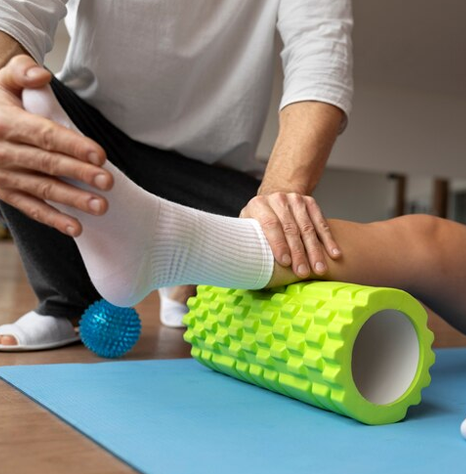
Hip and Groin
Assessment and Diagnosis
Spondylolisthesis is a condition where one of the vertebrae slips forward over the vertebra below it. This can cause pain and affect the spinal nerves.
Individualized Treatment Plans
Tailored rehabilitation programs focusing on pain relief, strengthening, and functional restoration.
Support and Education
Providing patients with the knowledge and tools to manage their condition and prevent future injuries. Our goal is to assist you in recovering from hip and groin injuries and help you regain your quality of life, whether you are an athlete striving for peak performance or a busy professional with an active lifestyle.
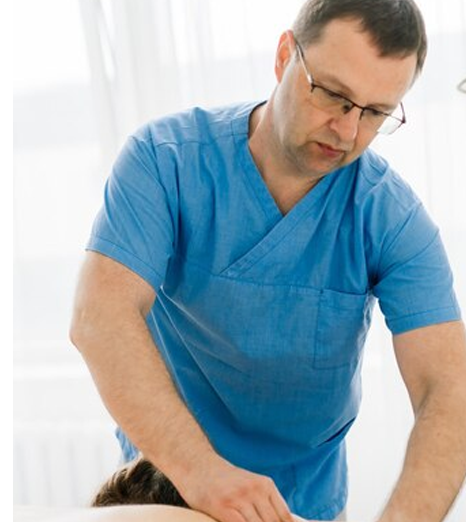
Knee
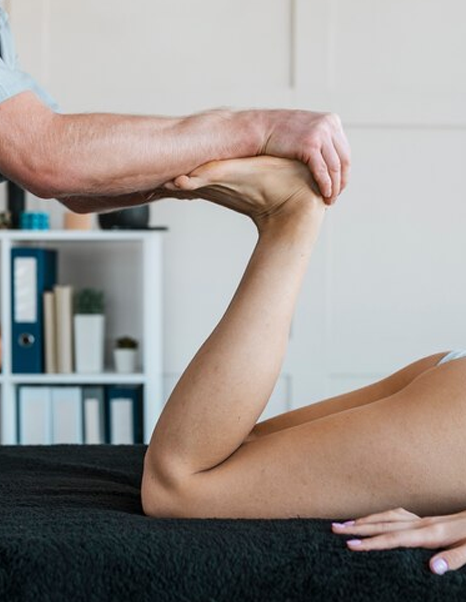
ACL and PCL Ligament Strains:
ACL Strain
The anterior cruciate ligament is crucial for stabilizing the knee, particularly in activities involving sudden stops and changes in direction. ACL injuries range from mild sprains to complete tears and often occur during sports. Symptoms include a “popping” sensation, pain, swelling, and instability.
PCL Strain
The posterior cruciate ligament is less frequently injured than the ACL but can be strained or torn through direct impact to the front of the knee or hyperextension. Symptoms include pain, swelling, and difficulty bearing weight.
Patella Dislocation
This occurs when the kneecap (patella) is forced out of its normal position, often to the outside of the knee. It can result from a direct blow or a sudden change in direction. Symptoms include severe pain, swelling, and visible displacement of the kneecap.
Meniscus Tears
The menisci are two C-shaped pieces of cartilage that act as shock absorbers between the thigh bone (femur) and the shin bone (tibia). Meniscus tears are common in sports and can result from twisting motions or direct impact. Symptoms include pain, swelling, stiffness, and difficulty moving the knee.
Knee Tendinopathy
This condition involves degeneration or inflammation of the tendons around the knee, such as the patellar tendon (jumper’s knee) or the quadriceps tendon. It is often due to overuse and repetitive stress. Symptoms include localized pain, tenderness, and swelling.
Post-Surgical Rehabilitation (Total Knee Replacement - TKR)
After a total knee replacement surgery, rehabilitation is critical to restore function, strength, and range of motion. Post-surgical care involves physical therapy, pain management, and gradual return to normal activities.
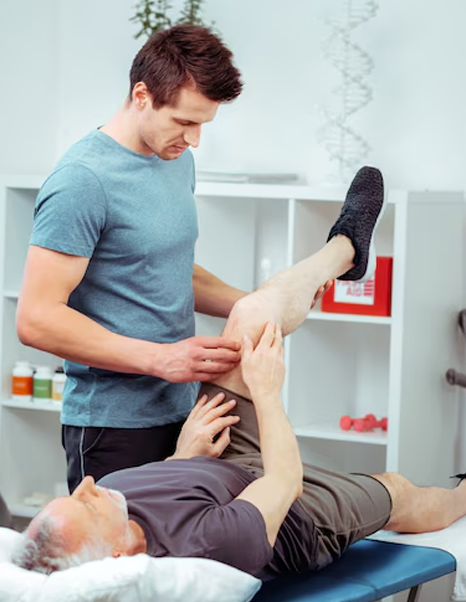
Neck
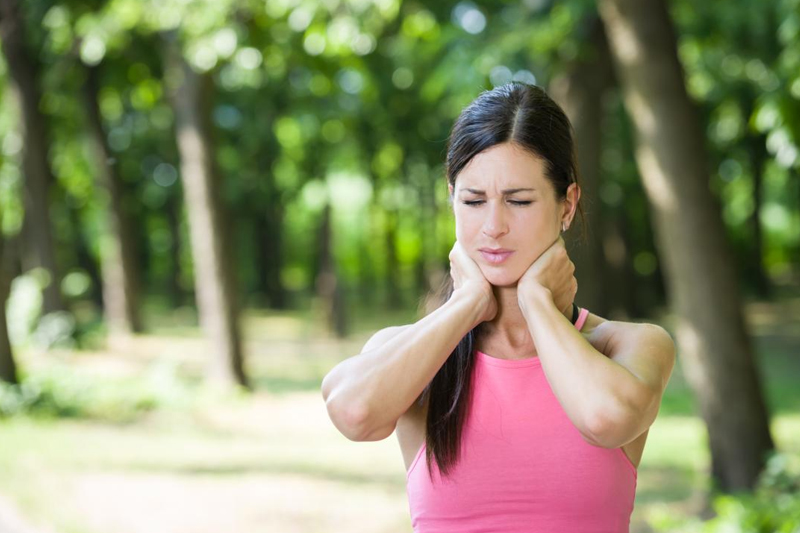
Migraines and Headaches
Cervicogenic Headaches: These headaches originate from the cervical spine and are often caused by issues in the neck’s bones, discs, or soft tissues.
Tension Headaches: Often related to muscle strain or stress, leading to tightness and discomfort in the neck and head.
Whiplash Injury
Cause: Sudden, forceful back-and-forth movement of the neck, commonly from car accidents.
Symptoms: Neck pain and stiffness, headaches, dizziness, and sometimes pain radiating into the shoulders and arms.
Muscle Strain or Spasm
Cause: Overuse, poor posture, or sudden movements can strain neck muscles or cause spasms.
Symptoms: Pain, stiffness, and limited range of motion.
Cervical Spondylosis
Cause: Age-related wear and tear affecting the spinal discs in the neck. This can lead to osteoarthritis.
Symptoms: Neck pain and stiffness, possible numbness, and tingling in the arms and hands due to nerve compression.
Torticollis (Wry Neck)
Cause: Muscle spasm or congenital conditions causing the head to tilt to one side.
Symptoms: Pain and stiffness on one side of the neck, difficulty turning the head.
Pre/Post surgery
Shoulder

Shoulder dislocation / instability

Rotator Cuff injuries

Tendinopathy

Acromioclavicular joint strains

Post shoulder surgery
Soft Tissue Injury
Soft tissue injuries involve damage to muscles, ligaments, and tendons, commonly resulting from overuse, direct impact, or sudden movements. These injuries can range from mild strains to severe tears and are frequently seen in both athletes and individuals engaged in regular physical activities.
Common Symptoms of Soft Tissue Injuries
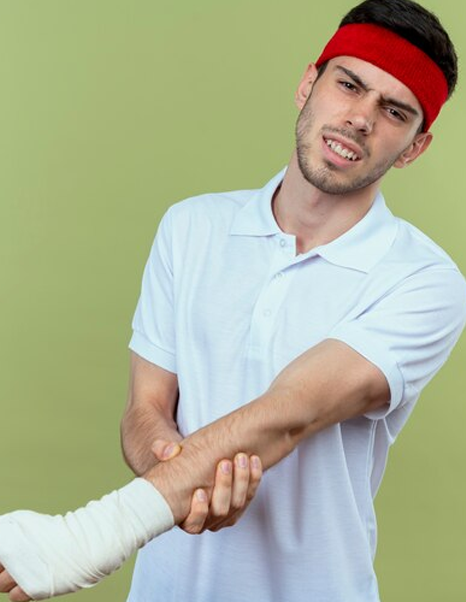
Pain
Immediate or delayed onset of pain in the affected area.
Swelling
Localized swelling due to inflammation and fluid accumulation.
Bruising
Discoloration of the skin resulting from bleeding beneath the surface.
Stiffness
Reduced range of motion and stiffness in the injured area.
Weakness
Decreased strength and function of the affected muscle or joint.
Tenderness
Sensitivity to touch or pressure on the injured site.
Instability
Feeling of joint instability or giving way, particularly in ligament injuries.
Evidence shows that early intervention in the management of soft tissue injuries significantly improves recovery outcomes and reduces the risk of reoccurrence
Sporting Injuries
Tennis elbow


